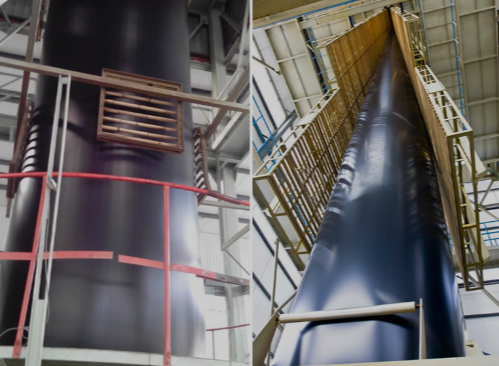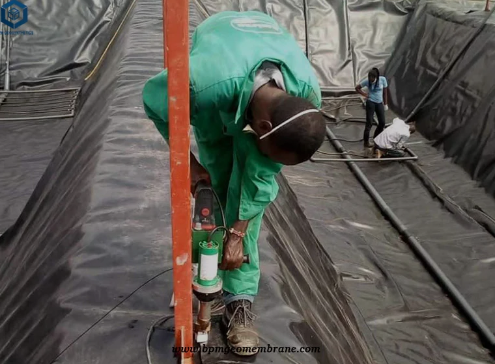- Understanding the Role of Geomembrane Liners in Waste Management
- Innovations in Geomembrane Liners for Water Management
- Geomembrane Liners: A Comprehensive Guide
- The Future of Geomembrane Liners in Civil Engineering
- Geomembrane Liners: Enhancing Landfill Stability
Manager:Alvin Wang
WhatsApp:+62 8983806051
Tel:+86 10-5797-1075
Email:steelwang@okorder.com
Address:3rd Floor, No.2 Building, No.1 Sanlihe Road
What is very hard HDPE geomembrane called?
High-Density Polyethylene (HDPE) geomembrane is the most commonly used material in civil engineering and geotechnical applications because of its lastingness, flexibility, and ability to prevent liquids from passing through. hdpe Geomembrane has been used in various environmental protection infrastructures including landfills, ponds irrigation canals and wastewater treatment plants to prevent leakage of liquid or gas to the surrounding environment. However, there is a specialized kind of it that lies within the scope of geomembrane technology which is known for its remarkable hardness and stiffness. In this article, we attempt to answer the question: What is very hard HDPE geomembrane called?

Understanding HDPE Geomembrane
Before looking at this special type we need to appreciate what High-Density Polyethylene (HDPE) geomembrane means. High-Density Polyethylene (HDPE) geomembrane refers to a synthetic liner made from high-density polyethylene resin. It’s a thermoplastic material with excellent chemical resistance, mechanical properties, and flexibility traits making it applicable in multiple containment systems.
Standard HDPE Geomembrane
Standard HDPE geomembranes exhibit some level of flexibility and conformability allowing them to adapt well on uneven surfaces as well as accommodate movement due to ground subsidence. Although this flexibility proves beneficial in many applications, there are instances where more rigidity may be required so as meet certain performance criteria.
Very Hard HDPE Geomembrane
The very hard variation on the other hand also known as high modulus or stiff geomembranes constitutes an exceptional type of geosynthetics compared with standard HDPE liners. This type has been transformed by changing its composition or manufacturing technique so that it exhibits greater resistance against deformation or tearing even when being stretched by force.
Advantages of Very Hard HDPE Geomembrane
Very hard HDPE geomembrane has several advantages over standard varieties, making it applicable for specific usage where additional stiffness and resistance to piercing are required. Some of the major advantages include:
1. Enhanced Puncture Resistance: The increased hardness of very hard HDPE geomembrane ensures that it is puncture and tear resistant thus making it appropriate for use in areas with sharp objects or abrasive materials.
2. Improved Dimensional Stability: When subjected to heavy loads, very hard HDPE geomembrane does not stretch much nor undergo dimensional changes thereby ensuring permanence and integrity in severe environments.
3. Reduced Creep and Deformation: Very hard HDPE geomembrane is very stiff meaning that it doesn’t distort as a result of continuous loading hence giving stable service life.
4. Enhanced Seaming Performance: In comparison to flexible liners like its counterpart, this rigid fabric is easy to weld into seams hence more reliable joints which are less susceptible to leaks or breakages.
Applications of Very Hard HDPE Geomembrane
Very hard HDPE geomembranes find application in situations requiring a higher level of stiffness and improved puncture resistance. Some common applications include:
1. Mining and Tailings Management: Very hard HDPE geomembranes are used in mining operations as lining materials for tailing ponds, leach pads, storage facilities among others, which enhances the containment of dangerous substances and prevents pollution of environment.
2. Industrial Waste Management: In industrial waste management sites such as containment basins, storage tanks or chemical processing zones; very hard HDPE liners are used as they provide strong barriers against highly corrosive fluids including hazardous wastes.
3. Hydraulic Structures: To curb erosion or seepage leakages while at the same time saving water resources; canals reservoirs or dams may be lined with very had HPDE liners (Saidi et al., n.d.).
4. Landfills and Environmental Remediation: Hard high-density polyethylene (HDPE) geomembrane is used in landfill liners, caps, and covers to prevent the migration of leachate and contamination of groundwater as well as in environmental remediation projects for containment or isolation of contaminated soil and groundwater.

Conclusion
In conclusion, very stiff HDPE material is a special type designed to have stiffness, puncture resistance and dimensional stability greater than those offered by ordinary high density polyethylene(Geomembrane Liner). Such a specialized product has various merits in applications that require strong containment for hazardous waste materials, prevention of environmental pollution, or long-term performance in demanding conditions. Based on understanding how unique very hard HDPE properties are utilized in different fields by engineers one can choose any lining that will meet required performance requirements.
-
2024-12-05Geomembrane Liners: A Comprehensive Guide






